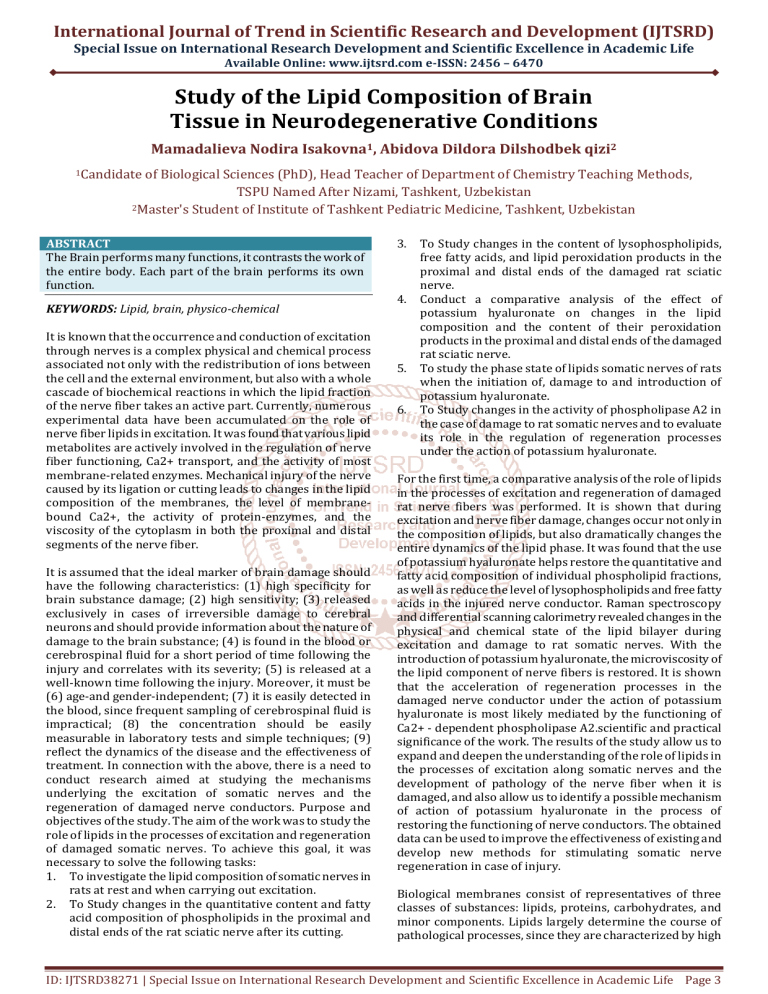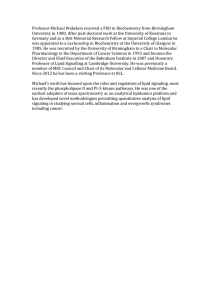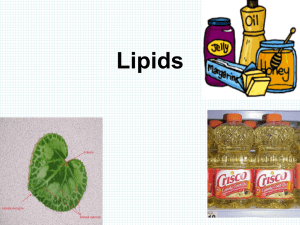
International Journal of Trend in Scientific Research and Development (IJTSRD) Special Issue on International Research Development and Scientific Excellence in Academic Life Available Online: www.ijtsrd.com e-ISSN: 2456 – 6470 Study of the Lipid Composition of Brain Tissue in Neurodegenerative Conditions Mamadalieva Nodira Isakovna1, Abidova Dildora Dilshodbek qizi2 1Candidate of Biological Sciences (PhD), Head Teacher of Department of Chemistry Teaching Methods, TSPU Named After Nizami, Tashkent, Uzbekistan 2Master's Student of Institute of Tashkent Pediatric Medicine, Tashkent, Uzbekistan ABSTRACT The Brain performs many functions, it contrasts the work of the entire body. Each part of the brain performs its own function. KEYWORDS: Lipid, brain, physico-chemical It is known that the occurrence and conduction of excitation through nerves is a complex physical and chemical process associated not only with the redistribution of ions between the cell and the external environment, but also with a whole cascade of biochemical reactions in which the lipid fraction of the nerve fiber takes an active part. Currently, numerous experimental data have been accumulated on the role of nerve fiber lipids in excitation. It was found that various lipid metabolites are actively involved in the regulation of nerve fiber functioning, Ca2+ transport, and the activity of most membrane-related enzymes. Mechanical injury of the nerve caused by its ligation or cutting leads to changes in the lipid composition of the membranes, the level of membranebound Ca2+, the activity of protein-enzymes, and the viscosity of the cytoplasm in both the proximal and distal segments of the nerve fiber. It is assumed that the ideal marker of brain damage should have the following characteristics: (1) high specificity for brain substance damage; (2) high sensitivity; (3) released exclusively in cases of irreversible damage to cerebral neurons and should provide information about the nature of damage to the brain substance; (4) is found in the blood or cerebrospinal fluid for a short period of time following the injury and correlates with its severity; (5) is released at a well-known time following the injury. Moreover, it must be (6) age-and gender-independent; (7) it is easily detected in the blood, since frequent sampling of cerebrospinal fluid is impractical; (8) the concentration should be easily measurable in laboratory tests and simple techniques; (9) reflect the dynamics of the disease and the effectiveness of treatment. In connection with the above, there is a need to conduct research aimed at studying the mechanisms underlying the excitation of somatic nerves and the regeneration of damaged nerve conductors. Purpose and objectives of the study. The aim of the work was to study the role of lipids in the processes of excitation and regeneration of damaged somatic nerves. To achieve this goal, it was necessary to solve the following tasks: 1. To investigate the lipid composition of somatic nerves in rats at rest and when carrying out excitation. 2. To Study changes in the quantitative content and fatty acid composition of phospholipids in the proximal and distal ends of the rat sciatic nerve after its cutting. 3. 4. 5. 6. To Study changes in the content of lysophospholipids, free fatty acids, and lipid peroxidation products in the proximal and distal ends of the damaged rat sciatic nerve. Conduct a comparative analysis of the effect of potassium hyaluronate on changes in the lipid composition and the content of their peroxidation products in the proximal and distal ends of the damaged rat sciatic nerve. To study the phase state of lipids somatic nerves of rats when the initiation of, damage to and introduction of potassium hyaluronate. To Study changes in the activity of phospholipase A2 in the case of damage to rat somatic nerves and to evaluate its role in the regulation of regeneration processes under the action of potassium hyaluronate. For the first time, a comparative analysis of the role of lipids in the processes of excitation and regeneration of damaged rat nerve fibers was performed. It is shown that during excitation and nerve fiber damage, changes occur not only in the composition of lipids, but also dramatically changes the entire dynamics of the lipid phase. It was found that the use of potassium hyaluronate helps restore the quantitative and fatty acid composition of individual phospholipid fractions, as well as reduce the level of lysophospholipids and free fatty acids in the injured nerve conductor. Raman spectroscopy and differential scanning calorimetry revealed changes in the physical and chemical state of the lipid bilayer during excitation and damage to rat somatic nerves. With the introduction of potassium hyaluronate, the microviscosity of the lipid component of nerve fibers is restored. It is shown that the acceleration of regeneration processes in the damaged nerve conductor under the action of potassium hyaluronate is most likely mediated by the functioning of Ca2+ - dependent phospholipase A2.scientific and practical significance of the work. The results of the study allow us to expand and deepen the understanding of the role of lipids in the processes of excitation along somatic nerves and the development of pathology of the nerve fiber when it is damaged, and also allow us to identify a possible mechanism of action of potassium hyaluronate in the process of restoring the functioning of nerve conductors. The obtained data can be used to improve the effectiveness of existing and develop new methods for stimulating somatic nerve regeneration in case of injury. Biological membranes consist of representatives of three classes of substances: lipids, proteins, carbohydrates, and minor components. Lipids largely determine the course of pathological processes, since they are characterized by high ID: IJTSRD38271 | Special Issue on International Research Development and Scientific Excellence in Academic Life Page 3 International Journal of Trend in Scientific Research and Development (IJTSRD) @ www.ijtsrd.com eISSN: 2456-6470 lability, and the products of lipid metabolism cause destructive changes in the membrane. It is known that a violation of lipid metabolism and the intensity of the processes of lipid peroxidation (LPO) leads to a violation of the transport of Ca2+ and normal cell metabolism. The main lipids that make up the membranes of nerve fibers are phospholipids, glycolipids, and steroids. In the nervous tissue, the following percentage of different classes of lipids is noted: phospholipids make up 43 %, cholesterol - 28 %, gangliosides - 29 %. At the same time, the main share of phospholipids in the nervous tissue is accounted for by phosphatidylethanolamine and phosphatidylcholine. The ratio of different lipid fractions is not constant and changes in various pathological conditions. It is known that many factors can affect lipid metabolism. Among them, the most important are radical reactions of lipid peroxidation and phospholipase activity. Therefore, it becomes obvious that from the point of view of the possibility of controlling the morphofunctional state of the cell, these components should be given priority. Thus, a violation of lipid metabolism is an initiating link in the pathogenesis of various diseases and requires targeted and timely correction. The relevance of studying neurodegenerative processes, new diagnostic and therapeutic approaches is related to the priority direction of modern neurology, which aims to achieve a high quality of life for patients, inhibition and transfer, ultimately, to remission of diseases, which could lead to the preservation of medical and social adaptation of patients and optimization of the quality of life. Despite the fundamental research carried out in the field of molecular neurobiology, pharmacology and gene therapy and reaching new frontiers in the knowledge of the pathophysiology of this disease, methodological approaches to the diagnosis and treatment of neurodegenerative pathology remain extremely relevant. REFERENCES [1] Surkova S. M. Metabolism of brain lipids in endotoxicosis: dis. ... candidate of medical Sciences. Saransk, 2006. 117 p. [2] Kruglik R., Farska I. Lithium and nucleotide metabolism in brain tissue//Journal of neuropathology and psychiatry-1974-no. 8. - pp. 1186-1188. [3] Lapach S. N., A. V. Chubenko, P. N. Babich Statistical methods in biomedical research using Excel. Kiev: MORION, 2000. - 320 p. [4] Richardson E. P., Beal M. F., Martin J. B. Degenerative diseases of the nervous system. // in the book: Internal diseases. Ed. By T. R. Harrison. - M.; "Medicine", 1997. - Vol. ID: IJTSRD38271 | Special Issue on International Research Development and Scientific Excellence in Academic Life Page 4






